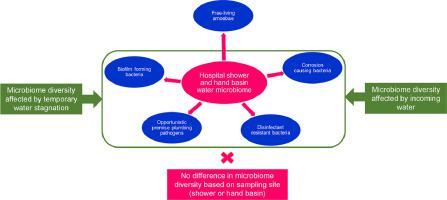Water Research ( IF 11.4 ) Pub Date : 2023-07-15 , DOI: 10.1016/j.watres.2023.120363
Muhammad Atif Nisar 1 , Kirstin E Ross 1 , Melissa H Brown 2 , Richard Bentham 1 , James Xi 3 , Jason Hinds 3 , Tamar Jamieson 4 , Sophie C Leterme 5 , Harriet Whiley 2

|
In recent years, the frequency of nosocomial infections has increased. Hospital water systems support the growth of microbes, especially opportunistic premise plumbing pathogens. In this study, planktonic prokaryotic communities present in water samples taken from hospital showers and hand basins, collected over three different sampling phases, were characterized by 16S rRNA gene amplicon sequencing. Significant differences in the abundance of various prokaryotic taxa were found through univariate and multivariate analysis. Overall, the prokaryotic communities of hospital water were taxonomically diverse and dominated by biofilm forming, corrosion causing, and potentially pathogenic bacteria. The phyla Proteobacteria, Actinobacteriota, Bacteroidota, Planctomycetota, Firmicutes, and Cyanobacteria made up 96% of the relative abundance. The α-diversity measurements of prokaryotic communities showed no difference in taxa evenness and richness based on sampling sites (shower or hand basins), sampling phases (months), and presence or absence of Vermamoeba vermiformis. However, β-diversity measurements showed significant clustering of prokaryotic communities based on sampling phases, with the greatest difference observed between the samples collected in phase 1 vs phase 2/3. Importantly, significant difference was observed in prokaryotic communities based on flow dynamics of the incoming water. The Pielou's evenness diversity index revealed a significant difference (Kruskal Wallis, p < 0.05) and showed higher species richness in low flow regime (< 13 minutes water flushing per week and ≤ 765 flushing events per six months). Similarly, Bray-Curtis dissimilarity index found significant differences (PERMANOVA, p < 0.05) in the prokaryotic communities of low vs medium/high flow regimes. Furthermore, linear discriminant analysis effect size showed that several biofilm forming (e.g., Pseudomonadales), corrosion causing (e.g., Desulfobacterales), extremely environmental stress resistant (e.g., Deinococcales), and potentially pathogenic (e.g., Pseudomonas) bacterial taxa were in higher amounts under low flow regime conditions. This study demonstrated that a hospital building water system consists of a complex microbiome that is shaped by incoming water quality and the building flow dynamics arising through usage.
中文翻译:

医院建筑供水系统中浮游原核生物群落的组成取决于进水和水流动力学
近年来,医院感染的发生率有所增加。医院供水系统支持微生物的生长,尤其是机会性前提管道病原体。在这项研究中,通过 16S rRNA 基因扩增子测序对从医院淋浴间和洗手池采集的水样中存在的浮游原核生物群落进行了表征,这些水样在三个不同的采样阶段收集。通过单变量和多变量分析发现各种原核生物类群的丰度存在显着差异。总体而言,医院用水的原核生物群落在分类上具有多样性,并且以生物膜形成、腐蚀和潜在致病细菌为主。变形菌门、放线菌门、拟杆菌门、浮菌门、厚壁菌门和蓝细菌门占相对丰度的 96%。原核生物群落的 α 多样性测量显示,基于采样地点(淋浴或洗手盆)、采样阶段(月份)以及Vermamoeba vermiformis的存在或不存在,类群均匀度和丰富度没有差异。然而,β-多样性测量显示,基于采样阶段的原核生物群落存在显着聚类,在第 1 阶段与第 2/3 阶段收集的样本之间观察到最大差异。重要的是,根据进水的流动动力学,在原核生物群落中观察到显着差异。Pielou 的均匀度多样性指数显示出显着差异(Kruskal Wallis,p < 0.05),并在低流量状态下显示出更高的物种丰富度(每周水冲水时间< 13 分钟且每六个月≤ 765 次冲水事件)。类似地,Bray-Curtis 相异性指数发现低流态与中/高流态的原核生物群落存在显着差异(PERMANOVA,p < 0.05)。此外,线性判别分析效应大小表明,几种生物膜形成(例如假单胞菌目)、引起腐蚀(例如脱硫杆菌目)、极耐环境压力(例如奇异球菌目)和潜在致病性(例如假单胞菌属)细菌类群的数量较高在低流量条件下。这项研究表明,医院建筑供水系统由复杂的微生物群组成,该微生物群是由进水水质和使用过程中产生的建筑水流动态决定的。

































 京公网安备 11010802027423号
京公网安备 11010802027423号